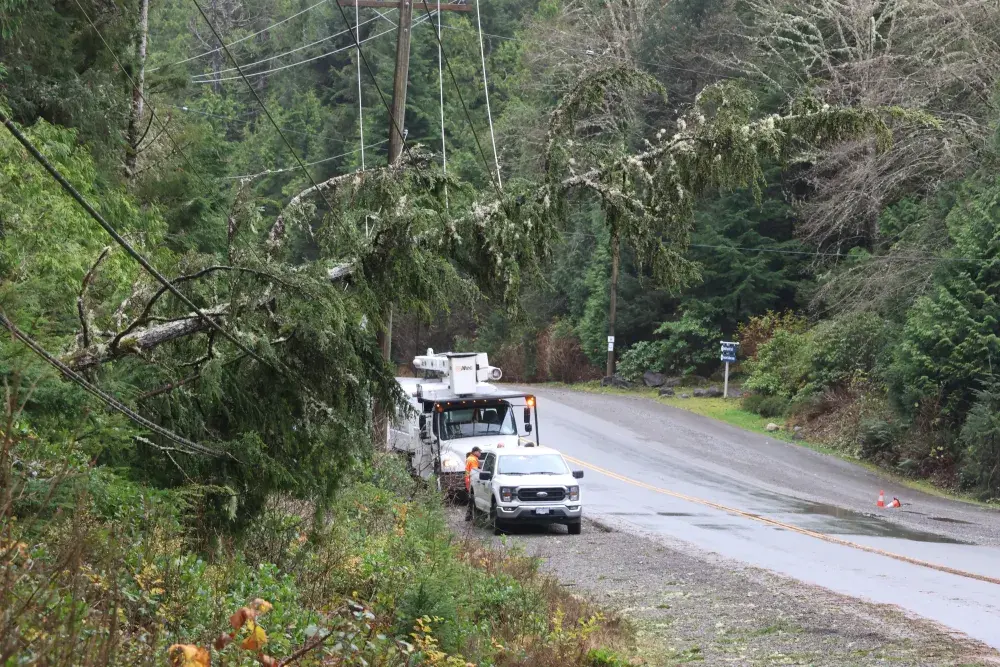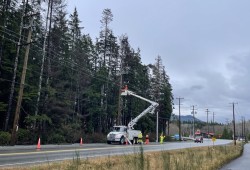Two days without power, Ahousaht and Tofino residents are heading into their third night without electricity, as BC Hydro works to recover transmission after the worst storm the utility has seen in almost six years.
As of mid-afternoon on Thursday, Nov. 21, Tofino, the Tla-o-qui-aht communities along Long Beach, Hitacu and Ahousaht’s village of Maaqtusiis on Flores Island were without electricity. In the afternoon of Nov. 19 power was cut to the coastal communities, along with approximately 300,000 people in B.C., when strong winds mixed with heavy rain caused trees to be uprooted across the province.
By 5 p.m. on the following day, power had been restored to 80 per cent of those affected, but all of Clayoquot Sound remained in the dark. Power didn’t return to Ucluelet until the following morning on Thursday.
Called a ‘bomb cyclone’ by meteorologists who delivered warnings as the storm approached, the hardest hit areas were on Vancouver Island, where winds off the west coast reached 170 kilometres an hour, according to Ted Olynyk, community relations manager with BC Hydro.
“This certainly ranks up there in the top couple of storms that I’ve seen,” he said. “It spared no one on this island, really, especially those exposed in the coastal areas.”
In Port Alberni residents were without power for approximately an hour on Tuesday evening as the storm wind howled overhead, and 25 power poles in the small city were damaged by falling trees.
“The Beaver Creek area is just a real mess,” said Olynyk.
Westbound the damage is more severe, where countless uprooted trees have challenged hydro crews working day and night to restore power to communities in Clayoquot Sound. Things are particularly bad along the stretch of Highway 4 between Ucluelet and Tofino.
“Damage is pretty significant, especially by the junction area. We’re sending more crews over from other parts of the island to help out with the work,” said Olynyk at midday on Thursday. “We hope to have most customers up, but there’s going to be pockets we may not get to. Working over in the area that feeds Ahousaht, I’m not sure of the timeline of that just yet.”
A submarine cable stretches from Tofino across the ocean floor to Flores Island, where the Ahousaht village of Maaqtusiis went without power since the storm hit. The remote community coordinated trips to Tofino for fuel to run generators and power non-electrical appliances. In the community’s Thunderbird Hall movies are being screened and meals served, tables lining the large building for the coordinated feasts.
“We have been doing our best to make direct contact with the BC hydro front-line workers for an update, no answer back thus far,” stated Curtis Dick from Ahousaht Emergency Response in an online update given on Thursday, noting that he had heard from the provincial government. “Emergency Management Climate Readiness has also called us and will be making contact to BC Hydro for an update status of our hydro. So please be patient and as soon as we hear anything we will pass it along to the community.”
Efforts to restore power to Clayoquot Sound were challenged by highway closures during the first few hours of the storm, when fallen trees blocked land passage. Some BC Hydro personnel living in Tofino and Ucluelet were able to respond quickly, but others could not access the west coast power lines due to Highway 4 being blocked until Wednesday morning.
Further south on the coast Bamfield and Anacla were without power for over a day. The blackout lasted 43.5 hours, according to Huu-ay-aht member Stella Peters, who saw extensive damage from the wind and rain blowing over trees. Fortunately, most people in the coastal Barkclay Sound region have wood stoves, propane appliances, diesel generators and canned food in storage, she said. It’s a lesson that has remained from the December 2006 storm that cut off power to the region for nine days, she said.
Over 250,000 people in the province lost power at the height of that storm. The weather event battered the Pacific Northwest, notably knocking down thousands of trees in Vancouver’s Stanley park, while Peters recalls Anacla’s household water source being cut off for five days due to the electrical disruption.
“Stanley Park made the news ‘cause trees came down, but we didn't make the news,” she commented.
Judi Thomas remembers that 2006 storm well, as it also affected the Ditidaht First Nation village of Nitinaht on southwest Vancouver Island. As of Thursday afternoon, Nov. 21, power had not been restored to Nitinaht.
“Our staff are really pulling together and we have warming stations in the community and hot soup going out,” said Thomas, who is chief councillor of the Ditidaht First Nation. “The Economic Development Corporation has gone the extra mile to make sure the store is open for warmth and their internet access as well. They’ve got a generator set up at the store running, keeping people warm and fed and socializing to keep some semblance of peace and a little bit of normality.”
The First Nation is running generators to power three internet sources to ensure connectivity in Nitinaht, which does not have cellular phone coverage.
Like other remote west coast communities, power outages are a regular occurrence during the stormy months in Nitinaht. Thomas said approximately 80 per cent of the village’s residents rely on non-electrical sources of heat, such as wood or propane stoves.
“A lot do, and then again there’s a lot of new people in the community that aren’t familiar, so it’s a learning curve for them,” she said.
Another part of life in the region is clearing the road to Nitinaht of vegetation to ensure a safe passage for others.
“Usually there’s trees down all over, but locals out of Nitinaht and community members, they drive the routes to make sure that they have a power saw in the back of their truck,” said Thomas. “They limb and cut and move trees out of the way. It’s become a way of life for people at Nitinaht to be prepared with power saws, candles, emergency food sources. They’re pretty resilient people.”
This month’s storm has been a challenge for coastal residents and the power utility, but for BC Hydro the worst weather event in the province’s history remains a December 2018 deluge and gale. At its height more than 750,000 people in B.C. were without power due to wind from multiple directions uprooting trees from ground that was already saturated by days of heavy rain.
As winter storms continue, BC Hydro works year-round to prevent more lines from being disrupted.
“We do pretty extensive vegetation management, making sure we clear the trees, vegetation that can contact our lines,” said Olynyk.
He reminds people to be cautious around downed lines that could still be live.
“If you see a downed line, stay 10 metres back,” urged Olynyk. “A line may not have tripped out when it hit the ground.”





